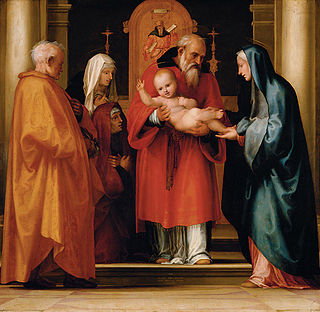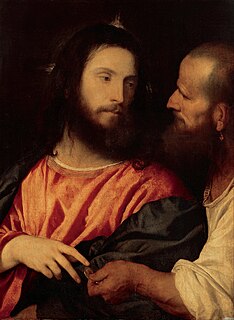 W
WAssumption of the Virgin is a c.1516 oil on panel painting by Fra Bartolomeo, commissioned by the church of Santa Maria in Castello in Prato. To the left of the Virgin's tomb is John the Baptist, whilst to the right is Catherine of Alexandria.
 W
WThe Bravo is an oil painting usually attributed to Titian, dated to around 1516-17 and now in the Kunsthistorisches Museum in Vienna. The painting can be seen as one of a number of Venetian paintings of the 1510s showing two or three half-length figures with heads close together, often with their expressions and interactions enigmatic. Most of these are "Giorgionesque" genre or tronie subjects where the subjects are anonymous, though the group includes Titian's The Tribute Money, with Christ as the main figure, which in terms of style is similar to this painting, and his Lucretia and her Husband, also in Vienna, where at least the woman's identity is clear, if not that of the man.
 W
WChrist Carrying the Cross is a painting attributed to a follower of Hieronymus Bosch. It was painted in the early 16th century, presumably between 1500 and 1535. The work is housed in the Museum of Fine Arts in Ghent, Belgium.
 W
WDeposition or Lamentation over the Dead Christ is a painting by Giovanni Bellini and his workshop, dating to 1515–16 and thus one of his last works. It measures 4.44 m by 3.12 m and is in oils on canvas. It was commissioned for the Santa Maria dei Servi church in Venice, which is now demolished; it is now in the Gallerie dell'Accademia in that city.
 W
WThe Double Portrait of Jakob Meyer zum Hasen and Dorothea Kannengießer is a 1516 oil on limewood panel painting by Hans Holbein the Younger. The two panels were commissioned by Jakob Meyer zum Hasen, mayor of Basel, and show him and his second wife Dorothea Kannengießer. They are the earliest surviving portraits by the artist and are linked to drawings he may have made in his hometown of Augsburg. Both panels are now in the Kunstmuseum Basel.
 W
WThe St. Cecilia Altarpiece is an oil painting by the Italian High Renaissance master Raphael. Completed in his later years, in around 1516–17, the painting depicts Saint Cecilia, the patron saint of musicians and Church music, listening to a choir of angels in the company of St. Paul, St. John the Evangelist, St. Augustine and Mary Magdalene. Commissioned for a church in Bologna, the painting now hangs in that city's Pinacoteca Nazionale. According to Giorgio Vasari the musical instruments strewn about Cecilia's feet were not painted by Raphael but by his student, Giovanni da Udine.
 W
WThe Entombment of Christ is a 1513–1516 oil on canvas painting by Lorenzo Lotto, now in the Accademia Carrara in Bergamo. It originally formed the central predella panel to the artist's Martinengo Altarpiece at the church of Santi Bartolomeo e Stefano. The other predellas were Saint Dominic Reviving Napoleone Orsini and The Stoning of St Stephen.
 W
WThe Haywain Triptych is a panel painting by Hieronymus Bosch, now in the Museo del Prado, Madrid, Spain. A date of around 1516 has been established by means of dendrochronological research. The central panel, signed "Jheronimus Bosch", measures 135 by 200 centimeters and the wings measure 147 × 66 cm. The outside shutters feature a version of Bosch's The Wayfarer.
 W
WThe Lute Player is a 1514-1516 oil on canvas painting by Giovanni Cariani, now in the Musée des Beaux-Arts in Strasbourg, France. Its inventory number is 236.
 W
WMadonna and Child with Saint Jerome and Saint Dorothy is a 1516 oil on canvas painting, now in the Kelvingrove Art Gallery and Museum in Glasgow, which purchased it from the McLellan collection in 1856. The Madonna's pose is based on that of Raphael's Esterhazy Madonna.
 W
WThe Madonna and Child with Two Musician Angels is an oil on panel painting by Correggio, now in the Uffizi in Florence. Some date it to 1514-15 but it is more commonly dated to 1515–16.
 W
WThe Madonna with Child and Saints, also known as Pucci Altarpiece, is a painting by the Italian late Renaissance painter Jacopo Pontormo, executed in 1516. It is housed in the church of San Michele Visdomini in Florence.
 W
WThe Martinengo Altarpiece is a painting by the Italian High Renaissance painter Lorenzo Lotto, finished in 1516. It is housed in the church of Santi Bartolomeo e Stefano in Bergamo in northern Italy.
 W
WThe Portrait of Andrea Navagero e Agostino Beazzano is a painting by the Italian High Renaissance painter Raphael, created in 1516. It is housed in the Galleria Doria Pamphilj, Rome.
 W
WThe Portrait of Cardinal Bibbiena is a portrait of Cardinal Bernardo Dovizi da Bibbiena by Raphael, painted around 1516 and now in the Palazzo Pitti in Florence. Its rendering appears more rigid than is usual for Raphael, leading some critics to attribute it to one of his pupils or to feel it is possibly a copy from a lost autograph original.
 W
WPresentation of Christ in the Temple is a painting by Fra Bartolomeo, probably commissioned by pope Leo X for Epiphany 1516. It originally hung in the novices' chapel in San Marco, Florence. It is inscribed with the year 1516. It is now in the Kunsthistorisches Museum in Vienna.
 W
WThe Raphael Cartoons are seven large cartoons for tapestries, belonging to the British Royal Collection but since 1865 on loan to the Victoria and Albert Museum in London, designed by the High Renaissance painter Raphael in 1515–16 and showing scenes from the Gospels and Acts of the Apostles. They are the only surviving members of a set of ten cartoons commissioned by Pope Leo X for the Sistine Chapel tapestries for the Sistine Chapel in the Vatican Palace, which are still hung below Michelangelo's famous ceiling. Reproduced in the form of prints, the tapestries rivalled Michelangelo's ceiling as the most famous and influential designs of the Renaissance, and were well known to all artists of the Renaissance and Baroque. Admiration of them reached its highest pitch in the 18th and 19th centuries; they were described as "the Parthenon sculptures of modern art".
 W
WThe Martinengo Altarpiece is a painting by the Italian High Renaissance painter Lorenzo Lotto, finished in 1516. It is housed in the church of Santi Bartolomeo e Stefano in Bergamo in northern Italy.
 W
WSaint John the Baptist is a High Renaissance oil painting on walnut wood by Leonardo da Vinci. Probably completed from 1513 to 1516, it is believed to be his final painting. The original size of the painting was 69 × 57 cm. It is now exhibited at the Musée du Louvre in Paris, France.
 W
WTransfiguration is a c.1515-1516 tempera on panel painting by Pordenone, now in the Pinacoteca di Brera in Milan.
 W
WThe Tribute Money is a panel painting in oils of 1516 by the Italian late Renaissance artist Titian, now in the Gemäldegalerie Alte Meister in Dresden, Germany. It depicts Christ and a Pharisee at the moment in the Gospels when Christ is shown a coin and says "Render unto Caesar the things that are Caesar's, and unto God the things that are God's". It is signed "Ticianus F.[ecit]", painted on the trim of the left side of the Pharisee's collar.
 W
WThe Virgin and Child with Saints Dorothy and George is a c.1516 oil on panel painting by Titian, now in the Prado Museum in Madrid, to which it was transferred in 1839.